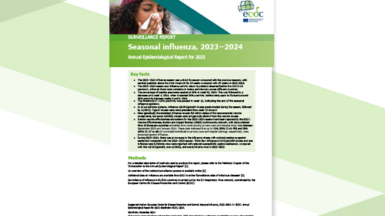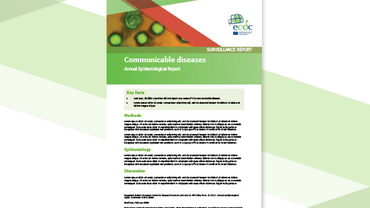Risk assessment: seasonal influenza 2011-2012 in Europe
The virological influenza pattern observed was not consistent enough to make a clear prediction for the 2011-2012 season in Europe. In general, the findings on the impact of influenza in the southern hemisphere in 2011 were reassuring for Europe, and the match of the A(H3N2) viruses with the vaccine was considered good.
Executive Summary
This was an especially important season as it was the first one after the pandemic. While most people experienced a mild disease when infected, a significant number of deaths and severe cases were reported in association with influenza in the first affected countries. In England, the peak was reached when, in one single day, for every 100,000 citizens, 1.4 -ere hospitalised in intensive care units suffering from influenza. In Ireland, the peak was reached when of every 100,000 citizens, 1.1 were hospitalised in intensive care units in one day.
The Risk Assessment identifies important differences between the current and past influenza seasons. People in the clinical risk groups defined at national level, which for this influenza season are predominantly people with underlying medical conditions and pregnant women, are being particularly affected by more severe ill-health and premature deaths as a result of influenza. However, surveys undertaken by the Member States and ECDC indicate that many of those at highest risk across Europe have not yet been vaccinated.
ECDC Director Marc Sprenger stressed: “Even in the middle of the influenza season, many preventable severe influenza cases and fatalities can still be avoided through vaccination. Therefore, it is extremely important that people in the risk groups who have not already been vaccinated seek the advice of their national authorities about influenza prevention. Being more vigilant over personal hygiene measures, such as washing hands frequently or avoiding touching the eyes, nose and mouth are also very useful strategies in preventing the spread of influenza infection”.
The good news is that both the seasonal and pandemic influenza vaccines are working very well in preventing infection and premature deaths. ECDC’s Risk Assessment highlights the multiple scientific studies that indicate seasonal influenza vaccines are effective and very safe. ECDC has now confirmed through a study recently conducted in seven EU Member States that the pandemic influenza vaccine can provide up to 80% protection against the pandemic influenza strain, which continues to be the most important cause of severe influenza this season. According to the study, protection against the pandemic influenza strain is provided as soon as one week after vaccination.
Related links:
1) Vaccine European New Integrated Collaboration Effort (VENICE) project
2) Valenciano M Kissling E, Cohen J-M, Oroszi B, Barret AS, Rizzo C et al Estimates of Pandemic Influenza Vaccine Effectiveness in Europe, 2009–2010: Results of Influenza Monitoring Vaccine Effectiveness in Europe (I-MOVE) Multicentre Case-Control Study. Plos Medicine PLoS Med 8(1): e1000388. doi:10.1371/ journal.pmed.1000388 (Published 11-01-2011).






